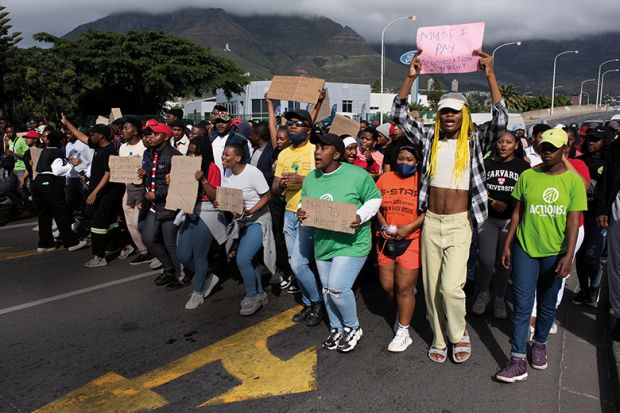Ahead of the start of the academic year next month, South African higher education is mired in crisis, amid claims of corruption and questions over the ability of the country’s student funding scheme to manage payments.
Higher education minister Blade Nzimande has been on the ropes for weeks following the publication of allegations that he took kickbacks from the National Student Financial Aid Scheme (NSFAS), a bursary for students from poor and working-class families, along with Ernest Khosa, its chair.
The accusations were levelled by the Organisation Undoing Tax Abuse (Outa), a civil society body, which shared as evidence what it said were voice recordings of Mr Khosa and representatives of NSFAS service providers. The alleged payments reportedly include a donation of one million rand (£41,100) to the South African Communist Party, which Mr Nzimande chairs, from the husband of a company director.
Mr Nzimande and Mr Khosa, who has voluntarily taken a month’s leave from his post while the allegations have been investigated, have both denied any wrongdoing. Mr Nzimande claimed that he was the victim of a “nefarious fightback campaign” linked to his own efforts to “fight corruption and ensure clean governance” at NSFAS.
But the allegations add to a sense of turmoil at the Department of Higher Education and Training (DHET), which oversees NSFAS and has lost a string of key senior staff members in recent months. Politicians, students and civil society groups have called for Mr Nzimande to be sacked. In addition, a DHET employee was recently arrested on suspicion of issuing a diploma certificate in exchange for cash, local media reported.
As the new academic year looms, meanwhile, NSFAS has missed a deadline that it set itself to pay outstanding allowances from last year to what it said was around 20,000 students. Only about 9,000 have been “successfully resolved” so far, according to the fund.
It blamed the continuing delays on universities failing to submit registration on time, but the South African Union of Students (SAUS) lamented what it said was NSFAS’ “regrettable and perpetual inability” to deliver on its mandate. SAUS said the 20,000 figure was probably a significant underestimate, because other students had been unable to get on to a new payment platform to receive their allowances.
NSFAS had already been rocked last October by allegations of “irregular conduct” by its then chief executive, Andile Nongogo, again in relation to the appointment of service providers, which pay around 1.1 million students their 1,650 rand monthly allowance directly, in contrast to previous arrangements when universities made the payments. Mr Nongogo was dismissed and his appeal against his termination was dismissed by a labour court in January.
Nico Cloete, the former director of the Centre for Higher Education Trust and coordinator of the Higher Education Research and Advocacy Network in Africa, questioned the wisdom of the 1999 decision to take responsibility for making bursary payments away from universities.
“The administration of giving the funds to students was taken away from the universities because in that system people at NSFAS and other national agencies could not steal the money. So this is a perfect storm of a lack of capacity combined with corruption,” he said.
Referring to the broader challenges facing the sector, Professor Cloete added: “This is of course the simple story of the new South Africa; a decrease in efficiency and an increase in corruption – a very sad [outcome] for higher education.”
An additional challenge facing NSFAS is the announcement in January by Mr Nzimande of a new loan scheme for students not currently eligible for NSFAS bursaries, from families with total annual incomes between 350,000 rand and 600,000 rand. Around half of the estimated 68,000 “missing middle” students are expected to become eligible for loans this academic year, ahead of a wider rollout from 2025-26 onwards.
Francis Petersen, chair of vice-chancellors’ representative body Universities South Africa, said that the issues facing NSFAS were a concern. South Africa’s 26 public universities are being hit with severe subsidy cuts this year, and Professor Petersen, vice-chancellor of the University of the Free State, said that on this basis it would have been better to implement the new category of support next year in the hope that current challenges could be ironed out in the meantime.
However, Professor Petersen said that universities were working with the ministry and NSFAS in the hope that “all challenges are fixed in real time”.
“I’m quite positive that, working together, we will be able to ensure that the new student funding doesn’t create further instability in the sector. And we need to get that sorted over the next couple of weeks,” he said.
Register to continue
Why register?
- Registration is free and only takes a moment
- Once registered, you can read 3 articles a month
- Sign up for our newsletter
Subscribe
Or subscribe for unlimited access to:
- Unlimited access to news, views, insights & reviews
- Digital editions
- Digital access to THE’s university and college rankings analysis
Already registered or a current subscriber? Login








